The untimely death of Warhammer Online, and the long road to resurrect it
There's no shortage of Warhammer games, but none quite like Warhammer Online: Age of Reckoning.
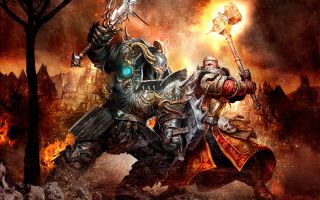
Someone at Games Workshop looked at Vikings, said, "These guys aren't heavy metal enough," and that's how we got Warhammer's Norse raiders.
In 2011, when Warhammer Online: Age of Reckoning was still around (though in decline), I once spent an entire night repeating a public quest to drive those spiky Norse axe jerks back from their beachhead. It was easy to join public quests like this one—just wander past and the current objective popped up in the corner of your screen—but we still couldn't get the nine players recommended for it. It was rare to see that many people in a zone, let alone a single quest. We tried a few times to complete it within its time limit, finally scraping through just before dawn.
I'm doing the same quest again today thanks to Return of Reckoning. A group of dedicated players have pulled together a private server and, though it's still in alpha, there's a working version of Warhammer Online playable today, six years after it was shut down by Mythic and EA.
But why? What is it about this MMO, never as beloved as City of Heroes, that's made people work so hard to resurrect it?
Norkalli, one of the volunteers working on Return of Reckoning, puts the appeal down to "immersive and challenging player versus player combat. From small scale one-versus-one tooth-and-nail duels, 6v6 competitive scenarios, up to several hundred players at a time clashing head to head and flank to flank."
Of all the RPGs that have come and gone since Warhammer Online debuted in 2008, none have done PvP quite like it.
Natherul, who heads the team, agrees. "There is simply something special with Warhammer and ORvR."
The biggest gaming news, reviews and hardware deals
Keep up to date with the most important stories and the best deals, as picked by the PC Gamer team.

The magic of realm vs. realm
"...the final epic moment of the ram breaking through the enemy front gates is hard to put into words."
Zarbix
ORvR, or Open Realm versus Realm combat, was brought across from Mythic's previous MMO, Dark Age of Camelot. Rather than wall off player-versus-player conflict in instances or on dedicated servers, there were roughly oval-shaped areas of the map—called "lakes" because of the shape, though they could be anything from beaches to forest—and as soon as you passed the artillery and barriers that marked their limits you'd be flagged for Realm vs. Realm, level-boosted to have appropriate stats, and let loose.
To prevent high-level players from dominating, each tier of lakes had a cutoff point. If you were too high-rank for one you'd be warned not to enter and then, if you persisted, transformed into a chicken.
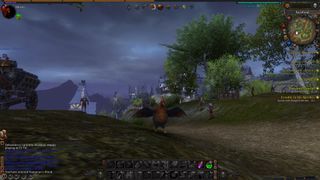
Warhammer Online had PvE and plenty of it, the public quests being a particular highlight, but the players most motivated to return are those who haven't found anything to replace the feeling of its PvP. Like Zarbix, who played Warhammer Online from its beta to its final day. "I think that once you experience the thrill of taking on another real person, in a game designed from the ground up with that as its focus, you can never really go back to collecting troll tusks again," he says.
"My best memory of the old Warhammer was possibly the first time we lay siege to the home city of the enemy realm. It hadn't been done before, and the amount of teamwork it required, the hours of not only fighting, but winning those fights, and the final epic moment of the ram breaking through the enemy front gates is hard to put into words."
Those city sieges, which had to be built up to by winning a series of keep battles, were an impressive back-of-the-box feature. But even on the smaller scale Warhammer Online's PvP had a lot going for it. Collision detection was turned on in the lakes, meaning that tanks could physically block attackers, while also absorbing some of the damage being directed at more fragile characters using their guard abilities. Meanwhile, healers were not only able to deal damage but encouraged to, with attack spells boosting the effectiveness of subsequent healing spells.
A lot of effort went into making every class, including the supports, actually fun to play.
"Age of Reckoning and now Return of Reckoning's playing field and class selection/faction composition is so large and varied there's nearly an infinite number of possible encounters with your enemy," says Norkalli, who puts this variety down to "the Warhammer setting and lore being so massive and thorough."
Apart from the occasional person running around in their underwear, everybody looked like they belonged in the same grim and perilous setting
Damage-dealing characters were more interesting than usual too. Bright wizards built up combustion points to trigger more powerful spells but risked explosions (Vermintide's bright wizard Sienna works in a similar way). Orc choppas had a rage stat that increased their damage output but also lowered their defense as they stoked it, witch elves stacked bloodlust to unlock combos, and goblin squig herders had big fungal beasts to control or even ride around inside. Every player seemed to have at least a couple of alts on each side of the order/destruction divide because they were all so tempting to try.
Although there were instanced scenarios to queue for, a lot of action took place in those ORvR lakes. The ability to bounce back and forth between PvP and PvE just by strolling through a warcamp and crossing a line made the two halves of Warhammer Online feel integrated in a way they usually aren't.
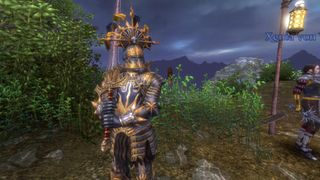
The focus on PvP had positive knock-on effects on the design of Warhammer Online as a whole. To make it easy for players to tell each other apart on the battlefield each class maintained a distinct silhouette. As a Knight of the Blazing Sun you started with a torn shirt, but once you upgraded to a shiny breastplate you looked like an armored knight for the rest of the game. There was personalization based on whether you chose sword-and-shield or two-handed greatsword, and you could toggle the helmet off so people could see your face better, but you were always going to look like the armored tank you were.
Big orcs and metal-plated Chosen of Chaos were designed to contrast with flimsy sorcerers zipping about on floating discs, and while the appearance options were limited compared to other MMOs the effect in-game was of a unified world. Apart from the occasional person running around in their underwear, everybody looked like they belonged in the same grim and perilous setting, and from a glance at someone's hat you could tell they were a witch hunter. Only the dark elves—a riot of black, pink, and purple like Prince fans going through a goth phase—were tricky to tell apart until you learned the distinctions.
Customization was still possible, but it happened mostly through color choice rather than gear selection. As well as a character creator with an excellent set of color options named after the official paints for Warhammer miniatures, plenty of quests handed out dye as a reward. The overall similarity between characters emphasized small differences, so that one bit of flair, whether a color choice, a medal, or a shoulder-mounted beer stein, seemed to matter all the more.

Age of Reckoning had plenty of things going for it, and it sold over 1.2 million copies in its first few weeks. Obviously not all of those players were online at once, but the server population peaked at a respectable 800,000. While its launch was beset by bugs and login problems like every MMO, it reviewed well and was considered a success.
But within months, that population had dropped to 300,000. Warhammer Online began a slow decline until Mythic eventually turned off the lights on December 18, 2013. EA closed Mythic Entertainment six months later.
End of an Age
Why did it fail?
"I feel like you'll have as many answers to this question as the number of people you ask," says Norkalli. "As the story goes, EA/Mythic Studios sunk enormous amounts of money up front to develop the game itself, and also paid exuberant fees to Games Workshop for the licensing rights to use Warhammer Fantasy and all associated IP."
Warhammer Online's successful launch was followed by a sudden exodus
Zarbix, who stuck with Warhammer Online "all the way until the last second of the last day" says it's a topic you could write a thesis about. "You could point to Mythic being bought by EA while the game was being made, the rushed development and launch that followed. Opening too many servers on day one, leading to many being deserted as people left, and an unprepared merging system for the remaining players. The game was lacking endgame content at launch, and the developers moved too slowly to fix game-breaking bugs and class balance problems."
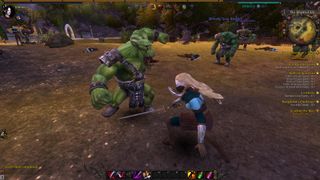
Zarbix lays the ultimate blame for Age of Reckoning's failure on its attempt to be a WoW killer. "The original developers wanted to not only compete with World of Warcraft," he says, "but they wanted to surpass it. This directly led to a game that tried to do everything, please everyone, and instead of focusing on what made Warhammer unique, they made it into World of Warhammer."
It's true that everything unique about Warhammer was superimposed on a traditional game of cooldown whack-a-mole combat and doing quests for people with icons over their heads. It ended up appealing to jaded World of Warcraft players who'd grown sick of the perceived stagnation of Blizzard's MMO (11 years ago!), but didn't want something radically different.
Unfortunately for Mythic, all it took was a shakeup of their old flame to win a substantial number of them back.
Age of Reckoning launched in September of 2008 and WoW's expansion Wrath of the Lich King came out in November. Warhammer Online's successful launch was followed by a sudden exodus of WoW players. That hurt the players who remained, too. Warhammer Online's PvP and public quests were designed for mass groups, and with lower player counts neither worked as they were supposed to.

Mythic lowered the requirements for public quests and merged servers as well as forcing new characters to begin in the Empire or Chaos starting zones by default (previously each of the six factions began in their own zone). A free trial that let players try it out until level 10 was also instituted, and a spin-off arena combat game was developed by BioWare, though it never made it out of beta. All these attempts to raise interest and smoosh existing players together were band-aids, and the only thing that might have saved Warhammer Online—a transition to full free-to-play in the manner of The Old Republic or The Lord of the Rings Online—wasn't finished in time to save it.
"The community can be both very harsh and very supportive"
Natherul
In its sad last months Warhammer Online looked empty in that haunting way spaces designed to be filled do, all weird gaps and gigantic interiors. Quest-givers standing around with nobody to take their quests, fields full of evenly spaced monsters with nobody to kill them, fires that nobody would ever take the mission to put out.
But some of the players in Age of Reckoning's final days were planning ahead, sneakily backing up their dying world. "I'm so happy and grateful to all the players that gathered packet data in the closing month of the game's life," Natherul says. Those players made it possible for an emulation project called WarEmu to get up and running, taking the data hijacked between Mythic's server and the client as its foundation.
The first attempt at turning that into a playable server was a closed project, but Return of Reckoning is open to anyone. It's still in alpha, but regularly updated.
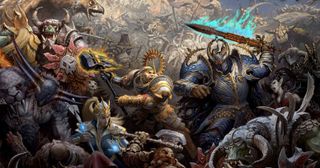
Return of Reckoning
So far, the volunteers running Return of Reckoning haven't faced any legal threats and Natherul says the team are taking precautions to avoid that ever happening. "Hence the fact that we do not accept donations of any kind," he explains. "We feel that because the game is dead, there is no other Warhammer online MMORPG, we stick to the lore that they provided, and we don't make any money on it, that there is little reason for them to hit us with legal troubles."
There are now 22 volunteers split over five different teams working on Return of Reckoning. Natherul joined the team in 2016 as a gamemaster and worked his way up from there. "I moved from gamemaster to community manager to database helper to source developer and lastly over to lead developer," he explains. "Though I stress that I'm not the best programmer in the team, I simply took a management position."
The hardest challenge he's faced from a technical standpoint was getting the different ground types to work, he says, having to differentiate between lava and water and deep water. On the less technical side, the community has presented the biggest challenge. "The community can be both very harsh and very supportive," he says, "and some decisions even when hated by the community at large can be what we deem as necessary evils."
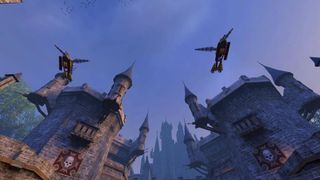
That's because Return of Reckoning isn't simply a recreation of Warhammer Online the day it died, but a continuation of it. According to Norkalli one of the best changes they've made is altering gear balance, which had a reputation while the game was live for being biased in favor of whatever was added in the most recent update.
"Here at RoR we've established a hard ceiling on how much of an advantage our top-tier equipment will be," he says, "and have flattened the curve considerably in order to make all the gear leading up to it follow a logical progression path such that the longer you play, the stronger you become—but not to the point which the equipment you have will be the determining factor in the outcome of a fight."
...finally a tree collapses and a giant bursts out of the forest to attack.
The forum does not always agree with choices like this. A particularly controversial addition has been the malus system. "I myself don't like it," says Natherul, "but it's needed as otherwise there was no incentive to not move over to the winning side in a campaign." Basically, when one faction outnumbers the other by two to one, rewards for killing other players are taken away. "It was made just to prevent everyone from joining the same realm to reap the rewards for just overwhelming the other realm with no fight."
Zarbix is one of the players who is happy with the alterations Return of Reckoning has made. "There are some purists out there that would prefer the game be an exact carbon copy of Age of Reckoning when it closed down," he says. "I'm actually completely fine with the changes, and I think they've mostly been for the better. The reality is that the original game had some big problems," he says.

Even with the malus system there are plenty of one-sided battles. I've been on both sides of them and they're not much fun, whether I'm taking a keep with ease as part of a horde or losing a scenario within minutes of joining it. And the PvE isn't perfect either (but then, it never was).
In the Imperial starting zone there's a public quest about defending a farm that will be the first many players encounter. There's a great escalation, from a battle against Chaos worshippers, then their beastmen allies, until finally a tree collapses and a giant bursts out of the forest to attack. A bunch of low-level characters (plentiful in this beginning area) have to band together to defeat it. When you do it's a hell of a rush.
In Return of Reckoning that quest's bugged. It never ends, and nobody gets their reward for slaying the giant. Meanwhile in the Blighted Isles high elves stand perfectly still while you target bolt throwers at them, and in the Greenskin starting zone a memorable quest where you get flung into a dwarf fortress via catapult doesn't work at all.
Moments like this remind me I'm playing an alpha, and we're here to report bugs as much as we are to have a good time.

And yet I'm back on the Nordland beach, facing the Norse raiders again. At first there are only two of us burning the invaders' tents and killing their weaker troops to complete stage one. Stage two is to kill some Norse plunderers and destroy their boats, but by the time I've finished fighting plunderers on the shore the boats are already burning. Three more players have arrived, including an elven shadow warrior who jumps everywhere and is named Memehole.
Over 240,000 players have registered for Return of Reckoning, but its server population typically hovers around 800 during the peak European hours and has a limit of 1,500. There are enough people to find allies and enemies, though they're clustered around the high and low levels.
My spontaneous group on the beach face the quest's final stage: A boss fight with a Norse captain named Hralgar the Kraken. As a Knight of the Blazing Sun I'm the tank here, so I taunt the big jerk and trade blows while the others whittle him down. With surprising speed—we're probably overleveled—he falls. I've waited seven years to be able to do this again, and this time it didn't take an entire night.
Zarbix is having a good time too. He's turned his dedication into a series of videos helping new players get up to speed, and can regularly be found in the thick of the PvP shooting fire spells around. "I've been playing a flame-flinging bright wizard for almost 13 years now," he says, "so it will always hold a special place in my heart. If you like to be a ranged damage dealer who quite literally explodes your enemies before they even know what hit them, this is perfection. That is, if you don't mind potentially blowing yourself up from time to time!"
For Norkalli, graduating from a fan to a member of the team working to keep Warhammer Online going has been the most fulfilling thing. "Any time I pour hours into working under the hood to create content for the community and receive indirect positive feedback that people are logging in and having fun, I feel satisfied that I could help keep the Warhammer fantasy world alive," he says.
"Also, occasionally winning 6v6 scenarios is pretty fun too."
Want to try Return of Reckoning for yourself? Here's Zarbix with a tutorial on how to download and get it running.

Jody's first computer was a Commodore 64, so he remembers having to use a code wheel to play Pool of Radiance. A former music journalist who interviewed everyone from Giorgio Moroder to Trent Reznor, Jody also co-hosted Australia's first radio show about videogames, Zed Games. He's written for Rock Paper Shotgun, The Big Issue, GamesRadar, Zam, Glixel, Five Out of Ten Magazine, and Playboy.com, whose cheques with the bunny logo made for fun conversations at the bank. Jody's first article for PC Gamer was about the audio of Alien Isolation, published in 2015, and since then he's written about why Silent Hill belongs on PC, why Recettear: An Item Shop's Tale is the best fantasy shopkeeper tycoon game, and how weird Lost Ark can get. Jody edited PC Gamer Indie from 2017 to 2018, and he eventually lived up to his promise to play every Warhammer videogame.
Most Popular


